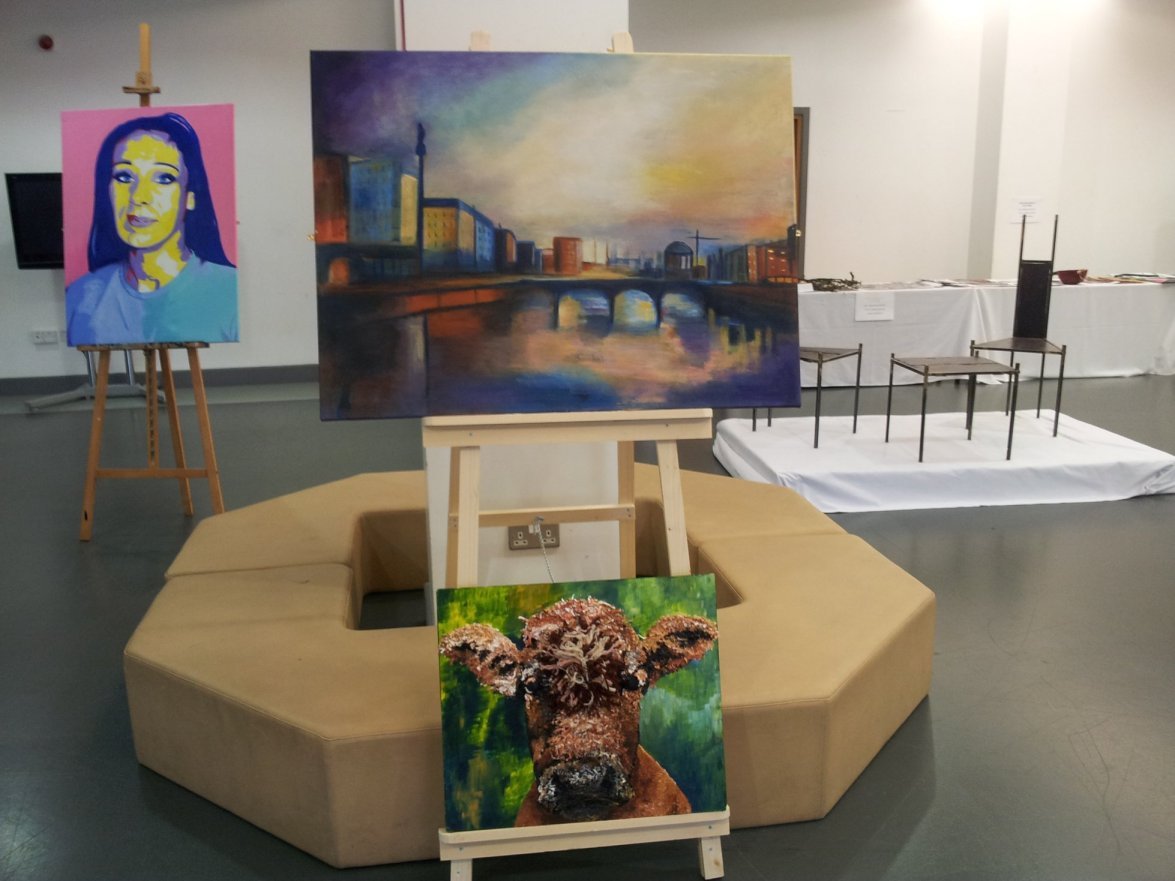
An exhibition by serving prisoners in HMP Hydebank and Maghaberry on display at Queen’s University, Belfast
Trusting the artists
The Prison Arts Foundation employs artists-in-residence in prisons in Northern Ireland. Alison Smyth explains their approach and achievements.
Back in 1996, the Prison Arts Foundation (PAF) was created in Northern Ireland to deliver a range of artforms in prisons. A number of organisations working in the criminal justice system, including the Probation Board for Northern Ireland, the Northern Ireland Prison Service and the Arts Council of Northern Ireland were the main drivers for the organisation. Their aim for PAF was to aid the rehabilitation of prisoners by helping them to express themselves and to encourage personal and social change, using a range of artforms, including creative writing, drama, visual art, sculpture, pottery, craft and music.
We currently provide 12 professional artists-in-residence who deliver a range of arts activities across three prisons and several project artists who work in artforms such as print-making and creative writing with ex-prisoners and people on probation. We are directly funded by the Arts Council of Northern Ireland, Lloyds TSB Foundation and the Northern Ireland Probation Board, and have a contract with the Northern Ireland Prison Service to provide 110 hours of professional, informal arts practice a week in HMP Magilligan, HMP Maghaberry and HMP Hydebank.
Art is a medium for change, prison is just a venue
As part of their residency role, the artists also put on exhibitions and performances, and produce publications of prisoners’ work. One of our artists created HMP Maghaberry’s first exhibition space, the Inside Out Gallery in the integrated visits area. To date, this gallery space has hosted ten thematic exhibitions launched by distinguished artists and leading figures in the creative sector. Due to its success, three more prison exhibition spaces have developed, including the Brightside Gallery. Other projects include exhibitions held in Hillsborough Castle and for the West Belfast Festival, ‘Time in Hand’, a large-scale wood sculpture installation situated in a busy prison courtyard, and several family projects in the visits and hospital areas. Last year all the artists produced pieces for a major exhibition of art, sculpture and crafts alongside the Turner exhibition, as part of the Derry-Londonderry City of Culture celebrations.
Being a PAF artist means being willing to work with prisoners of all ages, regardless of their status, ability or social background in inclusive and tolerant workshops. Although it can be a worthwhile and rewarding experience, working in a prison environment is not for everyone and professional artists can find it demanding. In recognition of the unique challenges faced by artists working in prisons, we are currently working with the Cred-ability project. This is an EU initiative to develop and share innovative methods of best practice across the prison systems of European member states, including Germany, Italy, Lithuania, Norway and the UK. In effect, this means our artists will receive a specialised teaching qualification in accordance with EU standards, specifically designed for artists who work in prisons.
PAF artists adopt an innovative approach to teaching, as opposed to more formal scholastic approaches that can often alienate prisoners, many of whom have had a bad experience of traditional educational methods. This enables the artists to gain the trust of prisoners who do not regard them as part of the system, which is essential to the development of a positive working relationship and the production of good work.
Our record of success in working in Northern Ireland’s prisons is exceptional. Exhibited artworks raise self-esteem, highlighting the ability of prisoners to do something positive that is valued by peers, families, the public and the prison service. Engaging in external exhibitions, such as the Koestler Awards and literary competitions, offers inmates the opportunity to have their artwork acknowledged by a wider audience with a view to sales of work and valuable exposure within an arts environment. However, for us the outcome is not just about the creation of products of value, it is about the process. Our artists are passionate about their work in prisons as they believe in the value of the arts as a tool for change and recognise their role as being vital in terms of building the self-esteem of those with profiles of social exclusion, including those dependent on drugs and alcohol, those with mental health issues and poor educational attainments.
Commenting on her residency, artist Ciara O Malley comments: “My work at HMP Maghaberry has given me the opportunity to create art works in a unique environment. I had the privilege to work with many creative and talented prisoners and staff who have shared Prison Arts Foundation’s vision and understood its potential to transform both the environment in which they live and work and themselves.”
We aim to reach out to those on the bottom rung of the socio-economic ladder, helping them to lead constructive lives upon release. Our motto is ‘Art is a medium for change, prison is just a venue’.
Alison Smyth is Director of Prison Arts Foundation.
www.prisonartsfoundation.com
Join the Discussion
You must be logged in to post a comment.